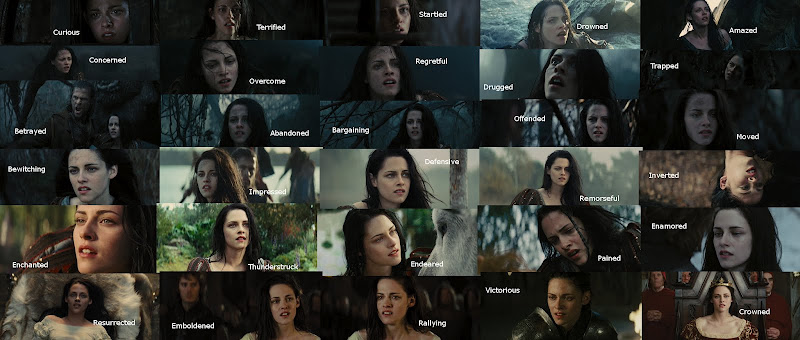1. A bad lead will kill your film. I realize that you and I are beggars so we can't be choosers, but keep this in mind: Even if you have the hots for someone, don't cast them if they aren't going to kick your movie up a notch. Stewart was amazing...ly... deadpan. I have created a graphic to illustrate:

The Many Faces of Kristen Stewart (click for larger version)
But we knew this already. Her's was the first face to make me wish the antagonist won when I saw the trailer all those many moons ago. Charlize is just that much more talented and compelling.
Do not let your personal feelings about an actor get in the way of telling your story.
2. Combine redundant characters. The Huntsman is pining for his lost love, can kick butt, and seeks to take care of Snow White. William has been pining for his lost love, can kick butt, and seeks to take care of Snow White. Ummm... make them one character!
I get it: Kristen's always up for a love triangle. But that's not what we have in this movie. In the end, neither boy is with her and we never see any of them connect. Plus, the idea of pure Snow White falling for two boys is out of character. She likes birds, not boys.
Girls like stories where they have to (get to?) choose between two boys. Typically this is the choice between the bad boy and the best friend. In Snow White's case it's the choice between the dude she just met and the guy she knew once a long time ago. ...again, the similarities are painful.
Even if your source material contains two characters, and you really like possibilities of playing them off each other, do yourself a favor and combine as many characters as possible. This is the role of adaptation. Your story will be much better for it.
3. Having a visual for your story is not visual storytelling. In the behind the scenes, there was lots of talk about storyboards and having a strong visual sense. Of course, if you watch Rupert's commercials and art pieces, you'll notice that a few the visuals from the film were borrowed from his other projects [NB: The video linked contains partial nudity... meaning, you don't see "anything" but there is a lot of naked skin].
Snow White has some really sweet images. But they have little to do with the story. Indeed, I'm willing to bet that the director even had some ideas as to what was going on when he filmed these scenes, but he failed to communicate why they were there. I've made much the same mistake ...as a film student. His producers and editors should have caught this and fixed it before releasing the movie.
Visual storytelling is the art of using images to convey your meaning. Snow White failed to do this over and over again. In fact, in the opening minutes when he actually had some visuals to tell his story (and actors strong enough to pull it off), he ruined it by slapping together a voice over from a character we won't meet for another 40 minutes and who does not, I might add, return to sum things up at the end.
I've recently written several posts that give examples of telling your story through moving pictures: using a visual vice, giving someone humanity, and gaining your audience's trust.
The end of the movie left us hanging. Not only did Kristen look no more interested in her coronation than she did, say, dying, but her two "love interests" were hardly there, and we were left with nothing at the end except a branch with blossoms on it that someone had hacked off a tree and left for Snow White to pick up. A symbol of life returning? Then why cut it off the tree? Why not zoom out of the throne room and past a blooming tree, a la Return of the King?
Please, as you work on your next script, remember to use your pictures to tell your story. Fight against the urge to have a narrator.
What was good? The costumes, some of the effects, and the reminder that you--even without fancy effects or big name actors--can make a better movie.
Now get to it!
~Luke Holzmann
Your Media Production Mentor

1 comment :
She needs the aunt in Temple Grandin to teach her some facial expressions.
Post a Comment